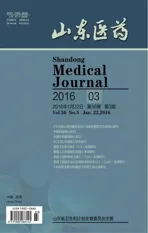人参皂苷Rg3对人结肠癌细胞株SW480增殖的影响及其作用机制
2016-03-23简捷刘利珍黄缘李双邓峰
简捷,刘利珍,黄缘,李双,邓峰
(1南昌大学第三附属医院,南昌 330008;2上海市嘉定区中心医院;3南昌大学第二附属医院)
人参皂苷Rg3对人结肠癌细胞株SW480增殖的影响及其作用机制
简捷1,刘利珍2,黄缘3,李双1,邓峰1
(1南昌大学第三附属医院,南昌 330008;2上海市嘉定区中心医院;3南昌大学第二附属医院)
摘要:目的观察人参皂苷Rg3对人结肠癌细胞株SW480增殖的影响,并探讨其可能作用机制。方法取对数生长期SW480细胞,分别加入含160、80、40、0 μmol/L人参皂苷Rg3的储备液(分别计为A、B、C、D组)培养24 h,采用MTT法检测人参皂苷Rg3对SW480细胞增殖活性(OD值)的影响,倒置显微镜观察人参皂苷Rg3诱导SW480细胞凋亡形态学改变,流式细胞术检测SW480细胞凋亡率,RT-PCR法检测细胞间黏附分子1(ICAM-1)、闭锁蛋白(Occludin)mRNA,Western blotting法检测ICAM-1、Occludin蛋白。结果与D组比较,A、B、C组细胞OD值下降,凋亡率增加,ICAM-1 mRNA、蛋白表达降低,Occludin mRNA、蛋白表达升高(P均<0.05)。结论 人参皂苷Rg3可抑制SW480细胞增殖,促进其凋亡,机制可能与ICAM-1表达下调、Occludin表达上调有关。
关键词:人参皂苷Rg3;结肠癌细胞株SW480;细胞间黏附分子1;闭锁蛋白
人参皂苷Rg3是从人参根的浸出液中分离出的一种有效成分,是一种微量四环三萜皂苷,可抑制肿瘤细胞新生血管形成,诱导肿瘤细胞凋亡,并能选择性抑制肿瘤细胞转移,提高机体免疫功能[1~3]。细胞间黏附分子(ICAM)在肿瘤生长、侵袭和转移中起重要作用,能介导异型细胞间及细胞-细胞外基质间的黏附作用,并参与免疫、炎症、肿瘤转移等一系列重要生理和病理过程。肿瘤的浸润、转移与上皮细胞的通透性密切相关,而闭锁蛋白(Occludin)是上皮细胞紧密连接中最重要的结构蛋白,可通过外环以拉链式结合产生严密的细胞旁封闭,还能与不同的分子结合,参与紧密连接形成的信号调节。本研究观察了人参皂苷Rg3对人结肠癌细胞株SW480增殖的影响,并探讨其可能机制。
1材料与方法
1.1细胞、药物及试剂SW480细胞购自上海沪尚生物科技有限公司。人参皂苷Rg3购自吉林亚泰制药股份有限公司,MTT和胰酶购自美国Sigma公司,Annexin V-FITC试剂盒购自美国Beckman Coulter公司,引物由上海Sangon公司合成,TRIzol试剂、逆转录试剂盒均购自美国Invitrogen公司,抗ICAM-1及Occludin抗体均购自英国Abcam公司,辣根过氧化物酶(HRP)标记的羊抗兔二抗购自北京全式金生物技术有限公司,RPMI1640培养基购自美国Gibco公司,胎牛血清购自杭州四季青公司。
1.2SW480细胞培养及人参皂苷Rg3配制细胞常规培养于含100 mL/L胎牛血清的RPMI1640培养液中。人参皂苷Rg3用二甲基亚砜(DMSO)溶解,配制成80 mmol/L的储备液,用培养液稀释至所需浓度,DMSO在各组培养液中的终浓度均为1 mL/L。
1.3人参皂苷Rg3对SW480细胞增殖影响观察取对数生长期SW480细胞,常规胰酶消化接种于96孔板,每孔4×103个细胞,培养24 h后,加入人参皂苷Rg3储备液,使其稀释后终浓度分别为160、80、40、0 μmol/L(分别计为A、B、C、D组),每组设6个平行孔,培养24 h后加入5 g/L的MTT共20 μL,再培养4 h后倒尽板中培养液,各孔加100 μL的DMSO,轻轻振荡后用酶标仪(波长490 nm)测定各孔的光密度值(OD值),以每组6个孔的平均值作为各组的平均值。实验重复3次。
1.4人参皂苷Rg3对SW480细胞凋亡影响观察常规培养SW480细胞,按1×105个/孔接种于24孔细胞培养板。分别用160、80、40、0 μmol/L人参皂苷Rg3处理SW480细胞24 h(分别计为A、B、C、D组),倒置显微镜下观察其形态变化。收集SW480细胞,PBS洗涤1次,400 μL Binding Buffer重悬细胞。取200 μL细胞悬液加入Annexin V 5 μL,PI 10 μL,避光20 min,加入200 μL Binding Buffer上机检测细胞凋亡率。用Cellquest软件获取数据,用Mod Fit软件进行数据分析。
1.5SW480细胞ICAM-1、Occludin mRNA检测采用RT-PCR法。常规收集经160、80、40、0 μmol/L人参皂苷Rg3处理24 h的SW480细胞(分别计为A、B、C、D组),总RNA提取按照TRIzol试剂说明书的操作步骤进行。逆转录为cDNA后使用LA Taq扩增ICAM-1、Occludin编码区域。PCR产物全部加入10 g/L低熔点琼脂糖凝胶进行电泳检测。利用Bandleader3.0软件分析PCR产物条带密度。结果以(目的基因OD值/β-actin基因OD值)×100%表示。
1.6SW480细胞ICAM-1、Occludin蛋白检测采用Western blotting法。常规收集经160、80、40、0 μmol/L人参皂苷Rg3处理24 h的SW480细胞(分别计为A、B、C、D组),提取细胞总蛋白,用Bradford法测定蛋白浓度。取5×106细胞,与2×SDS凝胶加样缓冲液等体积混合,100 ℃加热5 min后分装于-70 ℃冻存。细胞总蛋白每泳道上样30 μg,12.5%SDS凝胶电泳,1 mA/cm2半干转100 min,以含5%脱脂奶粉的TBST室温封闭2 h,分别加入一抗(ICAM-1单抗、Occludin单抗,1∶400稀释)4 ℃孵育过夜,二抗(IgG-HRP,1∶2 000稀释)37 ℃孵育1 h,ECL显影,凝胶成像系统扫描各条带灰度值,以此表示ICAM-1、Occludin蛋白的相对表达量。

2结果
2.1各组细胞OD值、细胞凋亡率比较结果见表1。

表1 各组细胞OD值、细胞凋亡率比较±s)
注:与D组比较,*P<0.05,△P<0.01。
2.2各组细胞ICAM-1 mRNA、Occludin mRNA、ICAM-1蛋白、Occludin蛋白比较结果见表2。

表2 各组细胞ICAM-1 mRNA、Occludin mRNA、ICAM-1蛋白、Occludin蛋白比较±s)
注:与D组比较,*P<0.05,△P<0.01。
3讨论
结肠癌是一种高发的恶性肿瘤,浸润和转移是影响患者预后的主要原因,但其转移扩散的具体机制尚不清楚。人参皂苷Rg3是中药中的一种抗肿瘤成分,目前其抗癌作用引起广泛关注。人参皂苷Rg3可以抑制肿瘤细胞的黏附、浸润、增殖,与化疗药联合应用可提高抗肿瘤作用。体内外实验及流行病学研究显示,人参皂苷Rg3对多种肿瘤均有增殖抑制作用。而通过体外抗浸润试验证明,人参皂甙Rg3能明显抑制小鼠腹水肝癌细胞、人小细胞肺癌和人胰腺癌细胞的单层浸润。研究[4,5]还发现,人参皂苷Rg3对高转移性的小鼠黑色素瘤细胞肺转移及小鼠结肠癌细胞肺转移具有抑制作用。本研究显示,A、B、C组细胞OD值较D组下降,凋亡率较D组增加,提示人参皂苷Rg3对SW480细胞有明显的抑制作用,并诱导其凋亡。
ICAM-1是由人第19对染色体编码的单链糖蛋白,其表达水平与肿瘤淋巴结转移、TNM分期密切相关[6,7]。恶性肿瘤的转移扩散,需借助于其细胞表面的黏附分子和细胞外基质及其他细胞的一系列相互作用,近年研究[8,9]表明ICAM-1与肝癌、胰腺癌、胃癌、结肠癌等肿瘤转移密切相关。上皮细胞是细胞黏膜屏障的主要组织结构基础,细胞间的连接复合体参与维持上皮细胞的完整性,其中紧密连接是细胞间最重要的连接方式。近来研究发现,肿瘤的浸润、转移与上皮细胞的通透性密切相关。上皮的通透性有两个途径,即跨上皮途径和细胞旁通路(紧密连接)。细胞旁通路是一组复杂的结构,主要由上皮细胞之间的紧密连接控制。细胞旁通路对内毒素和细菌的其他产物等大分子物质的通过起到关键性调控作用[10]。紧密连接和黏附连接与细胞的增殖和肿瘤的形成密切相关[11~13]。Occludin是紧密连接中最重要的组成蛋白,其人类基因定位于5q13.1,mRNA全长2 379 bp,编码522个氨基酸[14]。多数学者认为,Occludin表达的减少使紧密连接的渗透性增加,导致上皮间质转化,随后通道开放促进肿瘤的进展[15]。本研究发现,A、B、C组ICAM-1 mRNA、蛋白表达较D组降低,Occludin mRNA、蛋白表达较D组升高。提示人参皂苷Rg3可抑制SW480细胞增殖,促进其凋亡,机制可能与ICAM-1表达下调、Occludin表达上调有关。
参考文献:
[1] He BC, Gao JL, Luo X, et al. Ginsenoside Rg3 inhibits colorectal tumor growth through the down-regulation of Wnt/β-catenin signaling[J]. Int J Oncol, 2011,38(2):437-445.
[2] Choi YJ, Lee HJ, Kang DW, et al. Ginsenoside Rg3 induces apoptosis in the U87MG human glioblastoma cell line through the MEK signaling pathway and reactive oxygen species[J]. Oncol Rep, 2013,30(3):1362-1370.
[3] Usami Y, Ishida K, Sato S, et al. Intercellular adhesion molecule-1(ICAM-1) expression correlates with oral cancer progression and induces macrophage/cancer cell adhesion[J]. Int J Cancer, 2013,133(3):568-578.
[4] Zhang YH, Li HD, Li B, et al. Ginsenoside Rg3 induces DNA damage in human osteosarcoma cells and reduces MNNG-induced DNA damage and apoptosis in normal human cells[J]. Oncol Rep, 2014,31(2):919-925.
[5] Kim SM, Lee SY, Cho JS, et al. Combination of ginsenoside Rg3 with docetaxel enhances the susceptibility of prostate cancer cells via inhibition of NF-kappaB[J]. Eur J Pharmacol, 2010,631(1-3):1-9.
[6] Jung WC, Jang YJ, Kim JH, et al. Expression of intercellular adhesion molecule-1 and e-selectin in gastric cancer and their clinical significance[J]. J Gastric Cancer, 2012,12(3):140-148.
[7] Chowdhury MA, Xiubin Z, Wei H, et al. Cancer antigen-125 and ICAM-1 are together responsible for ascites in liver cirrhosis[J]. Clin Lab, 2014,60(4):653-658.
[8] Zhu XW, Gong JP. Expression and role of icam-1 in the occurrence and development of hepatocellular carcinoma[J]. Asian Pac J Cancer Prev, 2013,14(3):1579-1583.
[9] Liou GY, Döppler H, Necela B, et al. Mutant KRAS-induced expression of ICAM-1 in pancreatic acinar cells causes attraction of macrophages to expedite the formation of precancerous lesions[J]. Cancer Discov, 2015,5(1):52-63.
[10] Leech AO, Cruz RG, Hill AD, et al. Paradigms lost-an emerging role for over-expression of tight junction adhesion proteins in cancer pathogenesis[J]. Ann Transl Med, 2015,3(13):184.
[11] Chen L, Feng L, Jiang WD, et al. Intestinal immune function, antioxidant status and tight junction proteins mRNA expression in young grass carp(Ctenopharyngodon idella) fed riboflavin deficient diet[J]. Fish Shellfish Immunol, 2015,47(1):470-484.
[12] Leech AO, Cruz RG, Hill AD, et al. Paradigms lost-an emerging role for over-expression of tight junction adhesion proteins in cancer pathogenesis[J]. Ann Transl Med, 2015,3(13):184.
[13] Wang Q, Zhang Y, Zhang T, et al. Low claudin-6 expression correlates with poor prognosis in patients with non-small cell lung cancer[J].Onco Targets Ther, 2015,8:1971-1977.
[14] Ando-Akatsuka Y, Saitou M, Hirase T, et al. Intempecies diversity of the occludin sequence: cDNA cloning of human, mouse, dog, and rat-kangaroo homologues[J]. J Cell Biol, 1996,133(1):43-47.
[15] Lee NP. The blood-biliary barrier, tight junctions and human liver diseases[J]. Adv Exp Med Biol, 2012,763(1):171-185.
Effect of ginsenoside Rg3 on cell proliferation of human colon cancer cell line SW480 and its mechanism
JIANJie1,LIULizhen,HUANGYuan,LIShuang,DENGFeng
(1TheThirdAffiliatedHospitalofNanchangUniversity,Nanchang330008,China)
Abstract:ObjectiveTo observe the effect of ginsenoside Rg3 on the proliferation of human colon cancer cell line SW480, and to investigate its mechanism.Methods SW480 cells in the logarithmic phase were exposed to 160, 80, 40 and 0 μmol/L ginsenoside Rg3 for 24 hours (marked as groups A, B, C and D). MTT assay was used to measure the effect of ginsenoside Rg3 on the cell proliferative activity (OD value). Invert microscope was used to observe the morphological changes of SW480 cells, and flow cytometry was employed to measure the apoptosis of SW480 cells. The intercellular adhesion molecule 1 (ICAM-1) and occludin mRNA was measured by reverse transcription polymerase chain reaction (RT-PCR), and Western blotting was used to detect the expression of ICAM-1 and occludin protein.ResultsThe OD values were decreased, the apoptosis rates were increased, the expression of ICAM-1 mRNA and protein was decreased, and the expression of occludin mRNA and protein was increased in the groups A, B and C as compared with those of group D (all P<0.05).ConclusionGinsenoside Rg3 can inhibit the proliferation of SW480 cells and induce apoptosis, and its mechanism may be related with the down-regulated expression of ICAM-1 and up-regulated expression of occludin.
Key words:ginsenoside Rg3; colon cancer cell line SW480; intercellular adhesion molecule 1; occludin
(收稿日期:2015-09-15)
作者简介:第一简捷(1984-),男,硕士,主治医师,主要研究方向为消化道肿瘤相关基因。E-mail: 9957813@qq.com
中图分类号:R735.3
文献标志码:A
文章编号:1002-266X(2016)03-0008-03
doi:10.3969/j.issn.1002-266X.2016.03.003
